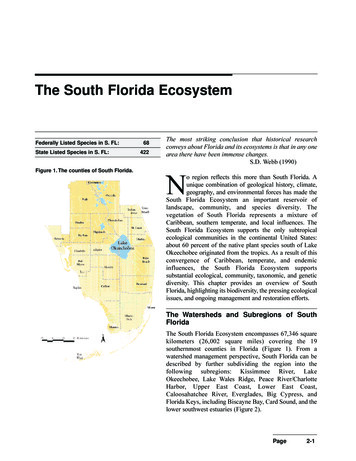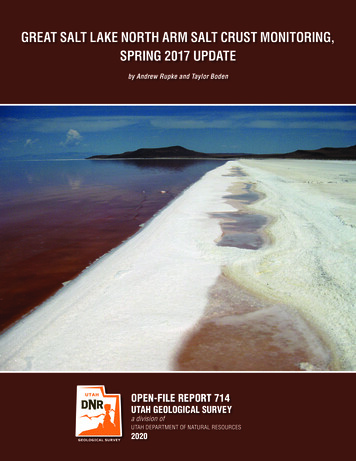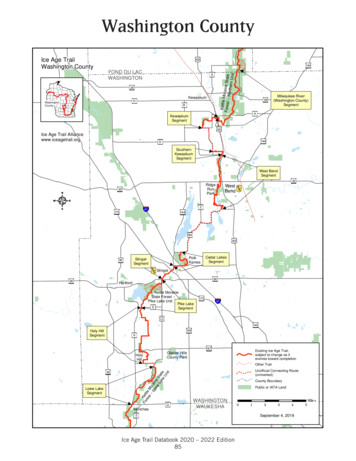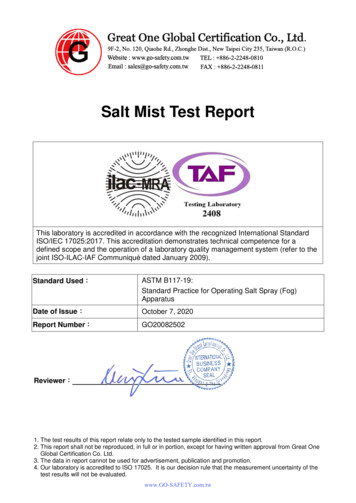
Transcription
DEPARTMENT OF THE INTERIORHUBERT WORK, SecretaryUNITED STATES GEOLOGICAL SURVEYGEORGE OTIS SMITH, DirectorWater-Supply Paper 517WATER POWERSOF THEGREAT SALT LAKE BASINBYRALF R, WOOLLEYWITH AN INTRODyCTIONBYNATHAN C. GROVERTM,COWI«PUBLIC PROPERTY.,.be removed from the dfficial files, PRIVATE P*4 . Sup. Vol. 2, pp. 360, Sec 749.)WASHINGTONGOVERNMENT PRINTING OFFICE1924
ADDITIONAL COPIESOP THIS PUBLICATION MAY BE PROCURED FROMTHE SUPERINTENDENT OP DOCUMENTSGOVERNMENT FEINTING OFFICE"WASHINGTON, D. C.»AT30 CENTS PER COPY
CONTENTS.PageSynopsis of report - - - -------- ------- ---- - Introduction, by N. C. GroverAcknowledgments.-. - - - -- - --- - ------Geography, geology, and physiography of the Great Salt Lake basin, byW. T. Lee . . . . . . . . . . . .Location.Problem outlines.-Geography.Geology.Character of the rocks - - . - ------- -j.- --Structure and dynamicsPhysiographyClimateGeneral conditions.Temperature !.Precipitation. -- - - - -- - ----Lake levels. . - - - - -- - - - -- - -.General featuresBear River basinWeber River basinPrincipal features - - -- -- - ---- Beaver CreekSilver Creek. i7 Chalk Creek - - - -- - - - ----- -- Echo CreekLost Creek " -- - --- --East Canyon Creek. ,Ogden RiverJordan River and Utah Lake basins - --- ------Utah Lake - -- --- - - .Principal features. - ----- -----Dry Creek . .American Fork.Battle Creek .Provo River and tributaries.Hobble Creek.Spanish Fork and tributaries -*---- - -- ,Payson or Peteetneet Creek.Santaquin CreekSalt or Currant CreekJordan River.Principal features.Little Cottonwood Creek - ---- - ------Cottonwood CreekMill Creek - - --- - ------Parleys Creek - -- ---City Creek - - ------ --- -.Willard, Farmington, and Box Elder creeks and streams in Tooeleand Rush valleys- - - - -- ---- 42526262629293031313131323233333334
IVCONTENTS.Page.Stream flow.Value of stream-flow recordsGaging stationsPublicationsReservoirs and reservoir sites.Bear River basinWoodruff Narrows siteYellow Creek and Coyote Creek sites .Bear Lake reservoir.Conditions below Bear Lake . -. - - -Cottonwood Creek site - -Reservoirs in Cache ValleyStrong Arm reservoirs.Oneida reservoir.Newton reservoirWorm Creek siteCub River siteLogan River sites.Blacksmith Fork site --- - -- --Little Bear River siteMalad River siteWeber River basinLarabee Flat site --- - -- - Beaver Creek site-----.--.-.---.------------------Rockport siteEcho siteSmith and Moorehouse site .Chalk Creek site -- - - -- ---- -Lost Creek siteYellow Creek and Coyote Creek sitesOgden River sites - - -- ------- Righthand Fork site.Cobble Creek siteMagpie site - ---- -- - - - - -East Canyon Creek reservoir.-------------- --Jordan River and Utah Lake basins.'Utah Lake.American Fork site - - .Hobble Creek siteProvo River sitesBates site. -Deer Creek site 'Other sites and reservoirs.Strawberry reservoir - --- Mount Nebo reservoirJordan RiverLittle Cottonwood Creek sitesCottonwood Creek sitesMill Creek siteParleys Creek reservoir.-City Creek sitesWillard, Farmington, and Box Elder creeks and streams in Tooeleand Rush 55556565658585959596061
CONTENTS.fPage .Developed water power'.General features.Bear River basinMcNeice plantSwan Creek plantParis plantOld Grace plantNew Grace plantCove plant--- -Oneida plant - - Wheelon plantGeorgetown plantSoda Springs plantHigh Creek plantLogan city plant - -- --- -Logan or Hercules plant - -Agricultural College plant - -- -Hyrum plantHyrum city 980Weber River basin 'Weber or Devils Gate plant - - - - --- - -----Riverdale plant- - - J -- - - -Butler plantPioneer plantSummaryJordan River and Utah Lake basinsAlpine plantUpper American Fork plant - -- - - - Lower American Fork plant -- - -Battle Creek plant.Springville plant - - -- ----Strawberry Valley project plantSantaquin plantNephi plant - - - - --Nephi Plaster & Manufacturing Co.'s plant.Murdock plantHeber Light & Power Co.'s plant. -Olmstead plantPark City or Ontario plant -Snake Creek plantJordan plantBennion plantColumbus Consolidated plantMurray city plantStairs plantGranite plantKnudson plantGordon plantLower Mill Creek plantUpper MiU Creek 39495959697989899100100101102103
VICONTENTS.Developed water power Continued.Willard, Farmington, and Box Elder creeks and streams in Tooeleand Rush valleys.Brigham city plantWillard plantDavis or Farmington plantTooele plant --- -- - - - - -South Willow plantOphir plant-.-.SummaryUndeveloped water power.Factors affecting capacity of power sitesAvailable flowSites in Bear River basinEvanston or Big Bend site.Wyuta sites.Woodruff Narrows siteMontpelier site . -- -. St. Charles site- -- -- --- - - - - -. Bloomington site - -- - l-Other sites on Bear River.Georgetown site.Co-op siteEightmile site -Soda Springs site - - -- - -- - - - --Bridge site. ---- - . - - - -- - -Mink Creek site - ---- ----Cub site - . - . ---Maple site - - - - - -High Creek site -Summit site. - -- - -- . - - - -- Logan River sites Blacksmith Fork sites - -SummarySites in Weber River basinOakley sites .Devils Slide siteWeber site.----. -------Chalk Creek site . .East Canyon site -- " - -Hardscrabble site.Ogden South Fork site - - - ------------- -------SummarySites in Jordan River and Utah Lake basins-American Fork sites - - -- Thistle site- 'Soldier Fork siteDiamond Fork sites - - - - - - - --- --- ---Payson site --- - - - - -- ----- .Santaquin site.Salt Creek site-- - --- - ------- . - -Provo River sites - - - -- - ----Little Cottonwood sites. ---Cottonwood 29130130130131133
CONTENTS.Undeveloped water power* Continued.Sites in Jordan River and Utah Lake basins Continued,Mill Creek siteParleyssiteCity Creek site .SummarySites on Farmington and South Willow creeksFarmington Creek site - - --- - - -South Willow Creek site 'RecapitulationWater rights and appropriations -. -- - - - - ---- --General conditions. - .State administrationMethods of acquiring water rightsWater-power rights in Great Salt Lake basin - - - -.Irrigation and its relation to the development of water powerMarket conditions in the Great Salt Lake basinNatural resources.Industrial development.Generation and distribution of power -- --- - -- - -- ,Diversified market in irrigation and mining districts.Relation of the Federal Government to the development of water powerLegal basis for Federal controL -Development of policy - - L --Duties and functions of the Federal Power Commission-------.--General administration of water powers-Design, construction, and operation of project works.Regulation of financial operations--.---.------------------*Regulation of rates and service - -- - - - - - --- - Valuation of properties of licensees-.General investigations - - -- - . - --- - ---Special investigationsRules and regulationsAppendix. Records of stream flowBear River basin - - -- - ----- -- ----- -- Bear River near Evanston, Wyo - -- - - - - -- Bear River at Harer, Idaho.Bear River at Dingle, IdahoBear River at Alexander, IdahoBear River near Collinston, Utah.Bear Lake inlet canal near Dingle, IdahoGeorgetown Creek near Georgetown, IdahoSoda Creek near Soda Springs, Idaho - - - -- - -- Logan River above State dam, near Logan, Utah.Logan River below State dam, near Logan, Utah -Logan River below Logan Northern canal, near Logan, Utah.Utah Power & Light Co.'s tailrace near Logan, UtahLogan, Hyde Park & Smithfield canal near Logan, UtahLogan Northern canal near Logan, Utah - -- -Blacksmith Fork above Utah Power & Light Co.'s dam, nearHyrum, Utah.Blacksmith Fork below Utah Power & Light Co.'s plant, nearHyrum, 97198200
tillCONTENTS.Appendix. Records of stream flow Continued.'Bear River basin Continued.Blacksmith Fork at Utah Power & Light Co.'s plant, near Hyrum,Utah.West Side canal near Collinston, UtahHammond (East Side) canal near Collinston, UtahLittle Malad River near Malad, IdahoBox Elder Creek at Brigham, UtahWeber River basinWeber River near Oakley, UtahWeber River at Devils Slide, UtahJordan River basinJordan River near Lehi, UtahSummit Creek near Santaquin, Utah.Peteetneet Creek near Payson, UtahSpanish Fork at Thistle, Utah. .Spanish Fork near Spanish Fork, UtahDiamond Fork near Thistle, UtahUnited States Reclamation Service power canal near SpanishFork, Utah.Hobble Creek near Springville, Utah -Provo River at Forks, Utah.Provo River near Provo, UtahSouth Fork of Provo River at Forks, UtahAmerican Fork near American Fork, UtahSouth Fork of American Fork near American Fork, -Utah. .Little Cottonwood Creek near Salt Lake City, UtahCottonwood Creek near Salt Lake City, UtahMill Creek near Salt Lake City, UtahParleys Creek near Salt Lake City, UtahEmigration Creek near Salt Lake City, Utah.City Creek near Salt Lake City, 67
ILLUSTRATIONS.Page.PLATE I. Key map showing location of Great Salt Lake basin4II. Diagrams showing fluctuations of Utah Lake, 1889-1922, andGreat Salt Lake, 1851-192316III. Map of the eastern part of the Great Salt Lake basin, showingthe development of water powerIn pocket.IV. Contour map of Beaver Creek reservoir site, Weber River basin,and section of dam - - -48V. Contour map of Echo reservoir site, Weber River basin, andsection of dam48VI. Contour map of Righthand Fork, Magpie, and Cobble Creekreservoir sites52VII. A, View down South Fork of Ogden River toward CobbleCreek dam site; B, Diversion dam of Pioneer plant in OgdenCanyon, near Ogden54VIII. Contour map of Bates reservoir site, on Provo River, and section of dam -54I. Contour map of Deer Creek reservoir site, on Provo River, andsection of dam54X. Panoramic sketch of Bear Lake and Bear River development.72*XI. A, Oneida plant; B, Wheelon plant on Bear River.72XII. A, Agricultural College power plant at mouth of Logan Canyon, near Logan; B, Hydroelectric plant built in OgdenCanyon in 188972XIII. A, View up Bear River at Soda Point dam site, near Alexander,Idaho; B, View down Bear River canyon toward Narrowsdam site, below Oneida development.73FIQTJBE 1. Diagrammatic section showing the structure of the WasatchRange in Ogden Canyon62. Area of Utah Lake at different levels.253. Plan of Woodruff Narrows reservoir site.414. Contour map of Lost Creek reservoir site.515. Sketch map showing Diamond Creek power sites and Strawberry reservoir-576. Plan of Oneida power development, Bear River, Idaho. .717. Typical hydrographs of streams in the Great Salt Lake basin.1108. Curves showing water-power development in the United Statesand in the Great Salt Lake basin155IX
SYNOPSIS OF REPORT.GEOGRAPHY,GEOLOGY,ANDPHYSIOGRAPHY OP THEGREAT SALTLAKE BASIN.The Great Salt Lake basin comprises that part of the Great Basin that drainsinto Great Salt Lake, Utah. It is about 27,000 square miles in area and includesthe northern part of Utah, a small part of eastern Nevada, the southeast cornerof Idaho, and the southwest corner of Wyoming.The eastern part of the area consists of mountainous highlands; the westernpart chiefly of low-lying plains. The lowest portion of the plain is occupiedby Great Salt Lake and minor parts by low mountain ranges. The area hasno outlet to the sea.The geologic features of the basin are important in a study of its water supplyand power possibilities in at least three ways, pertaining to the composition andphysical condition of the rocks, to their structure, and to the conditions resultingfrom dynamic processes. The rocks of the Wasatch Mountains, the principalmountain system in the basin, range in age from pre-Cambrian to Pleistocene.Most of the Paleozoic and older rocks are hard and either crystalline or metamorphosed. They are too nearly impervious to hold large quantities of water,and the run-off from their barren surfaces is extremely rapid. However, insome places they are so faulted or broken that much water is held in the cracksand gradually released at springs. The younger rocks that occupy the surfacein the eastern part of the basin and the slightly consolidated Pleistocene depositsthat occur in the mountains are more porous and absorb much of the precipitation that falls on them. Unconsolidated beds of talus or fragmental rock alongthe mountain slopes serve to retard the flow of the water derived from rain andfrom melting snow, so that the flow of the streams is somewhat regulated.The two general types of stream courses in the basin are those establishedbefore the last great rise of the mountains and those dependent on the presentmountain slopes. Weber Eiver is the best example of the first-mentioned type,and the short torrential streams, like Cottonwood Creek, are included in theother type. Bear and Ogden rivers represent modifications of the first type.Bear Eiver was probably deflected from its former course by a rise of the mountains, and Ogden River has its source in a basin that was once partly filled withwater but was eventually drained when the river cut its outlet low enough.CLIMATE.The general climate is of the arid or semiarid type. The maximum of precipitation occurs in the winter and spring. The precipitation increases rapidlywith altitude.The mean monthly and annual temperatures decrease with increase in altitude,uniformly in all months. The highest temperatures of record in the basin rangefrom 101 to 110 over the lower areas, and from 90 to 100 at the mountainstations. The lowest temperatures range from 10 to 20 below zero near GreatSalt Lake and Utah Lake to 35 or 50 below zero at Thistle, Laketown, Heber,Henefer, and East Portal. The average daily ranges of temperature are generally greatest during the warm, dry season from June to October, and leastXI
XIISYNOPSIS.from December to February. The growing season in the agricultural areas isfour to six months.The average annual precipitation ranges from less than 5 inches on the GreatSalt Lake Desert to more than 20 inches along the western slope of the WasatchMountains and to at least 30 inches on the higher westerly parts of this range.Lands lying about 4,250 feet above sea level along the base of the Wasatchslopes receive about 15 inches of precipitation annually. The principal agricultural lands have an average annual precipitation of 15 to 18 inches. Approximately 70 to 73 per cent of the annual precipitation on the basin falls fromNovember to May, and probably less than 13 per cent in June, July, and August.Droughts without rain of agricultural importance will last in some seasons from30 to 50 days in regions having about 15 inches of annual precipitation and from60 to 90 days in regions receiving from 8 to 12 inches.The annual snowfall ranges from about 3 feet at the lower levels to about 12feet at the higher points of observation.The evaporation from a water surface during the summer appears to be 35 to40 inches at Utah Lake and 40 to 45 inches at Nephi, as indicated by the shorttime records available.GENERAL FEATURES.Bear River basin. Bear River drains about 6,000 square miles of mountainand valley lands in the northeastern part of the Great Salt Lake basin. It riseson the north slopes of the Uinta Mountains, about 60 miles east of Salt LakeCity, flows northward into Wyoming and Idaho, turns to the southwest, andempties into Great Salt Lake. The course of the river is more than 300 mileslong, but the air-line distance from its source to its mouth is about 75 miles.The valley lands along the upper stretches of the river are chiefly suitable forraising hay, but those in Idaho and Utah are devoted to diversified farming.Dairying, farming, and cattle raising are the chief industries in the Bear Riverbasin.Weber River basin. Weber River rises in a number of small glacial lakes onnorthwest slopes of the Uinta Mountains, 50 miles due east of Salt Lake City.It flows in a general northwesterly direction through a series of small mountainvalleys and short rocky canyons in the Wasatch Range. Thence it winds acrossthe floor of the Great Salt Lake valley and empties into Great Salt Lake west ofOgden. It is about 125 miles long and has a total fall of 4,000 feet. More than40 tributaries empty into Weber River. The most important one in manyrespects is Ogden River, which drains about 400 square miles of mountainouslands in the Wasatch Range immediately north of the Weber River canyon.Ogden River flows westward through a rugged canyon cut into the WasatchRange and joins the Weber a few miles west of Ogden, in the Great Salt Lakevalley. Ogden Canyon is a picturesque scenic resort.Jordan River and Utah Lake drainage basins. Jordan River flows northwardfrom Utah Lake to Great Salt Lake, passing through the Jordan Narrows, whichconsist of low spurs of rolling hills that join the Wasatch and Oquirrh ranges.These Narrows form a low divide between the valleys, of Utah Lake and GreatSalt Lake. All the southern part of the Great Salt Lake drainage basin, comprisingsome 3,600 square miles, drains into Utah Lake. The lake serves as a reservoirto some extent, but by agreement between the canal companies that take waterfrom Jordan River and farmers who own land along the shore of the lake, thewater surface can not be raised in the lake sufficiently high to store all the floodwaters that run into it.
SYNOPSIS.xmAll the streams tributary to Jordan River are in the Great Salt Lake valleynorth of the Jordan Narrows, and the larger ones enter from the WasatchMountains, on the east. These streams are all short, derive their water frommelting snow and springs, and flow through steep, narrow V-shaped canyonsthat have rough, rugged rock walls.The principal streams flowing into Utah Lake also rise in the Wasatch Mountains, to the east and southeast of the lake. Most of them are similar to thetributaries of Jordan River, but a few are much larger and drain a greater area.Provo River is the largest one. It rises in several small glacial lakes in theUinta Mountains just south of the source of Weber and Bear rivers and flowssouthwestward through a series of valleys and canyons. It passes through theWasatch Range and enters Utah Lake valley near the town of Provo, finallyemptying into Utah Lake.Willard, Farmington, and Box Elder creeks and streams in Tooele and Rushvalleys, Willard, Farmington, and Box Elder creeks are small spring and snowfed mountain streams that flow from the west slopes of the Wasatch Rangebetween Salt Lake City and Brigham. They are short and fall rapidly throughtheir canyons. The canyon of Box Elder Creek is not so rugged nor so steep asthose of Willard and Farmington creeks, and the stream is larger. These streamsflow directly into the marshy areas along the east shore of Great Salt Lake.Tooele and Rush valleys lie south of Great Salt Lake, between the Oquirrhand Onaqui ranges, and are separated by a low divide near the town of Stockton.Both valleys are comparatively flat in the center and slope gradually northwardto Great Salt Lake. A number of streams flow into the valleys from the mountains on either side, but they are all small and many of them have intermittentflow, the channels being dry in the summer. All the flow is used for irrigation,and several hundred acres of land is reclaimed in and around the settlements ofTooele, Grantsville, Stockton, St. John, Clover, and Vernon.STREAM FLOW.In all studies of the utilization of stream flow it is imperative that records ofstream discharge be available in order to determine with some degree of accuracythe possibilities of development. Such records have been kept on most of theprincipal streams of the Great Salt Lake basin and on many of the smaller oneswhere power plants have been built. More than 65 gaging stations have beenestablished in the basin, and many valuable date have been obtained from them,but for many of the smaller streams no date are available.RESERVOIRS AND RESERVOIR SITES.The advance of irrigation and power development in the Great Salt Lakebasin has completely utilized the entire low-water flow of most of the streams,and progress is already being made in conserving the flood flow by buildingreservoirs. The largest reservoir in the basin is Bear Lake, whose capacity ismore than 1,400,000 acre-feet in the upper 23 feet. A pumping plant is situatedat the north end of the lake, on a natural causeway that forms the impoundingdam. Four smaller reservoirs have a combined storage capacity of 26,700 acrefeet. Considerable preliminary study has been made of 15 additional reservoirsites which, as planned, have a combined storage capacity of more than 300,000acre-feet.In the Weber River basin one reservoir has been constructed, with a capacityof 28,000 acre-feet, and 10 other reservoir sites having a proposed combinedcapacity of about 175,000 acre-feet have been investigated.In the Jordan River and Utah Lake drainage basins Utah Lake is used as areservoir, and it has an estimated capacity of 300,000 acre-feet at "compromise
XIVSYNOPSIS.level," a point a little more than 3 feet higher than the bed of Jordan River atthe outlet of the lake.The Strawberry Valley reservoir has a capacity of 250,000 acre-feet. Althoughit is not in the Great Salt Lake basin, it is a part of the' Strawberry Valley reclamation project. The water is brought into the basin through a tunnel and isused on lands in Utah Lake valley.A number of small lakes at the head of Cottonwood Creek and Provo Riverhave been developed as reservoirs, but the amount of storage is relatively small.In addition to the Utah Lake and Strawberry Valley reservoir storage the otherreservoirs in the Jordan River and Utah Lake area have a combined capacityof about 29,000 acre-feet. Nine possible reservoir sites and several small lakesat the head of Provo River have been investigated to some extent, and theestimated storage possibilities as shown by these studies amount to about176,000 acre-feet.The gross undeveloped storage capacity in the Great Salt Lake basin is estimated to be between 600,000 and 700,000 acre-feet, or approximately half ofthe storage capacity of Bear Lake.DEVELOPED WATER POWER.The development of hydroelectric power is one of the most important industries in the Great Salt Lake basin, and the water-power resources are ratherintensively developed, especially in that part of the basin in Utah, where thesettlement and industrial growth are concentrated. On practically every streamthat is large enough for an economical development of power there is one or morehydroelectric power plants, and in view of the many advantages of large-unitinstallation that have been acquired in the development of the industry in thelast 10 years, the possibility of increasing the number of small isolated plants isextremely remote. There are 50 plants in the basin having an installed waterwheel capacity of 225,149 horsepower at the end of 1923. Most of them aresmall.UNDEVELOPED WATER POWER.The amount of potential power at any power site ranges from the minimumto the maximum stream-flow capacity and can not be indicated by a definitefigure unless qualified by the time factor. Accordingly, the power capacitiesconsidered in this report are based somewhat arbitrarily on two time elements(a) the capacity available 90 per cent of the time, or that available during ordinarylow flow and for so great a part of the time that comparatively little pondagewill render it thoroughly reliable; and (6) the capacity available 50 per cent ofthe time, or that available when conditions of flow are such that though development is ordinarily warranted substantial storage regulation or auxiliary steampower must be provided to render the capacity thoroughly reliable. Only thosestreams that show a power capacity of at least 100 horsepower for 90 per centof the time have been considered in this report. The 65 sites that were investigated are estimated to be capable of furnishing about 56,000 horsepower for 90per cent of the time or 81,000 horsepower for 50 per cent of the time, with theexisting stream flow. With regulated flow these figures would be increased to80,000 and 115,000 respectively.
SYNOPSIS.XVWATEB EIGHTS AND APPROPRIATIONS.In the arid States irrigation is necessary to grow good crops, and the availableland is usually far more than can be properly irrigated by the available watersupply. It is therefore essential to .the proper utilization of the streams thatthe different water rights are defined and protected.The Great Salt Lake iDasin has streams in Wyoming, Idaho, and Utah, andin these States the streams are public property, the use of the waters of whichmust be acquired through application, and beneficial use is the measure of theright. In order that water rights may.be properly recorded and the unappropriated waters properly disposed of, each State has a State engineer or commissioner of reclamation, whose duty it is to protect the rights and interests in thestreams and take action on all new applications for water rights. The methodof acquiring these rights is, in general, the same in each State. The applicantmust first fi e an application, and upon approval of it he is permitted to proceedwith construction. When the water has been put to beneficial use in compliancewith the State law and the rules and regulations of the State engineer a license isissued for the amount of water upon which proof of beneficial use has been made.IRRIGATION AND ITS RELATION TO THE DEVELOPMENT OP WATER POWER.All the streams in the Great Salt Lake basin are used for irrigation, and morethan 800,000 acres of land is irrigated. Most of the power plants do not interferewith irrigation, because the streams in general are short and flow in their upperstretches through steep, narrow canyons. The power plants are in the canyons,most of them above all irrigation diversions. Some plants are built as adjunctsto irrigation enterprises, and there are irrigation diversions both above and belowa few plants. However, the use of water for irrigation has a preference rightover its use for power, and the development of power has been designed to avoidinfringement on irrigation rights. On Bear River power and irrigation are sointimately associated that the greatest utilization of the stream requires both,interests to be developed together, for the power furnishes the means of extendingirrigation to the bench lands which otherwise would not be reclaimed by gravitysystems.MARKET.In all water-power developments a market for the power is the factor thatdetermines the economic feasibility of the project, and where the power is to beused for public service it is the force that compels the development. The GreatSalt Lake basin and the surrounding territory are well provided with naturalresources, and the development of tnese resources has furnished an increasingmarket for power. The first plants in the basin were built to supply a smalllocal market near the plants, but in the last 12 years, since the advent of longdistance transmission, the interconnection of isolated plants, and the advance inreliability of service, the uses for power in the industrial world have increasedgreatly.The total connected power load in the basin is more than 270,000 kilowatts.The average load is 70,000 kilowatts, and the average monthly output is 50,4(30,000kilowatt-hours. The load comprises lighting, fuel, and power for more than 100communities, power for mining, interurban railroads, sugar factories, canneries,manufacturing establishments of various kinds, and irrigation pumping enterprises.The diversity of uses permits a much greater connected load than the installedcapacity of the plants and thus adjusts the total demand to such an extent thatthe load curve shows no excessive fluctuations.
XVISYNOPSIS.With the extensive coal and iron fields to the south of the basin, the hugesalt deposits near Great Salt Lake, and the manufacture of sulphuric acid as aby-product of the smelters, r
VI CONTENTS. Developed water power Continued. Page. Willard, Farmington, and Box Elde










